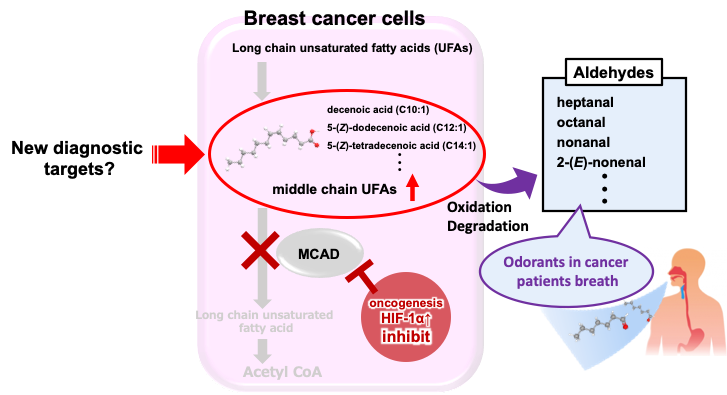研究成果 Research Results
- TOP
- News
- Research Results
- Potential targets found for diagnosing the onset of breast cancer
Potential targets found for diagnosing the onset of breast cancer
Breast cancer cells highly produced multiple medium-chain unsaturated fatty acids, which could behave as precursors for specific odorants in cancer patients’ breath 2020.09.08Research ResultsLife & Health
In a recent study, the Research and Development Center for Five-Sense Devices at Kyushu University reported that a series of medium-chain unsaturated fatty acids are present at high levels in breast cancer cell cultures, giving new potential targets for detecting the onset of breast cancer based on blood or urine samples.
Analysis of cell culture media revealed that the amount of two compounds of moderate volatility—that is, that do not quickly evaporate at room temperatures—were excreted in large amounts by breast cancer cells. Experiments showed that these compounds could produce volatile chemicals that have been found in the breath of various cancer patients.
“Our previous study for cancer screening by cancer sniffing dogs strongly suggests the presence of potential chemicals in breath for diagnosing cancer,” says Toshiro Matsui, director of the Research and Development Center for Five-Sense Devices and leader of the study published in PLOS ONE. “Our new studies now provide a series of potential biomarkers as precursors for these cancer-specific volatiles, and sampling and storage of the identified fatty acids are much easier than of the volatiles.”
By comparing the molecular characteristics of culture media of three breast cancer cell lines (MCF-7, SKBR-3, and YMB-1) and control normal cells (KMST-6), seven unsaturated fatty acids in all, including 1-hexadecanol and 5-(Z)-dodecenoic acid, were found with markedly higher levels. When these compounds were oxidized by H2O2, volatiles including heptanal and octanal were generated. The generated volatiles have been reported in exhaled breath of cancer patients.
These identified fatty acids have been reported to be substrates of medium-chain acyl-CoA dehydrogenase (MCAD), while MCAD might be downregulated by the activation of HIF-1α in cancer cells. These findings provide strong scientific rationales for the generation of the fatty acids found in this study by cancer cells.
“The Research and Development Center for Five-Sense Devices aims to be an academic division of five-sense integrated research by a cooperation between researchers of different fields based on the forefront technologies of taste and odor sensing. This achievement is one examples of the success such cooperation can yield. We are evaluating these compounds from human urine or blood samples, and we are also working on an analytical system and device for rapid quantification of these compounds for diagnosis on the spot,” comments Matsui.

New research shows that a series of medium-chain unsaturated fatty acids are highly excreted in culture media by breast cancer cells. Moreover, these fatty acids are oxidized to become volatile aldehydes that have been reported as cancer specific volatiles in breath from various cancer patients, indicating that the identified fatty acids serve as precursors of these cancer specific volatiles and are potential diagnostic targets for the onset of breast cancer.
###
For more information about this research, see “Identification of characteristic compounds of moderate volatility in breast cancer cell lines,” Mitsuru Tanaka, Chung Hsuan, Masataka Oeki, Weilin Shen, Asuka Goda, Yusuke Tahara, Takeshi Onodera, Keisuke Sanematsu, Tomotsugu Rikitake, Eiji Oki, Yuzo Ninomiya, Rintaro Kurebayashi, Hideto Sonoda, Yoshihiko Maehara, Kiyoshi Toko, and Toshiro Matsui, PLOS ONE, https://doi.org/10.1371/journal.pone.0235442
Research-related inquiries
Research and Development Center for Five-Sense Devices, Kyushu University
Contact information can also be found in the full release.
- TOP
- News
- Research Results
- Potential targets found for diagnosing the onset of breast cancer































